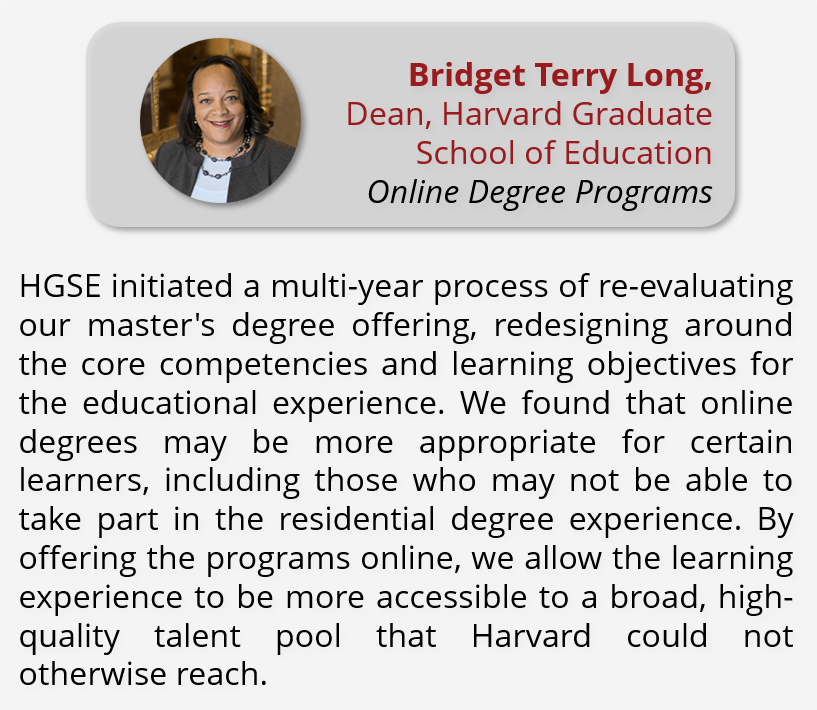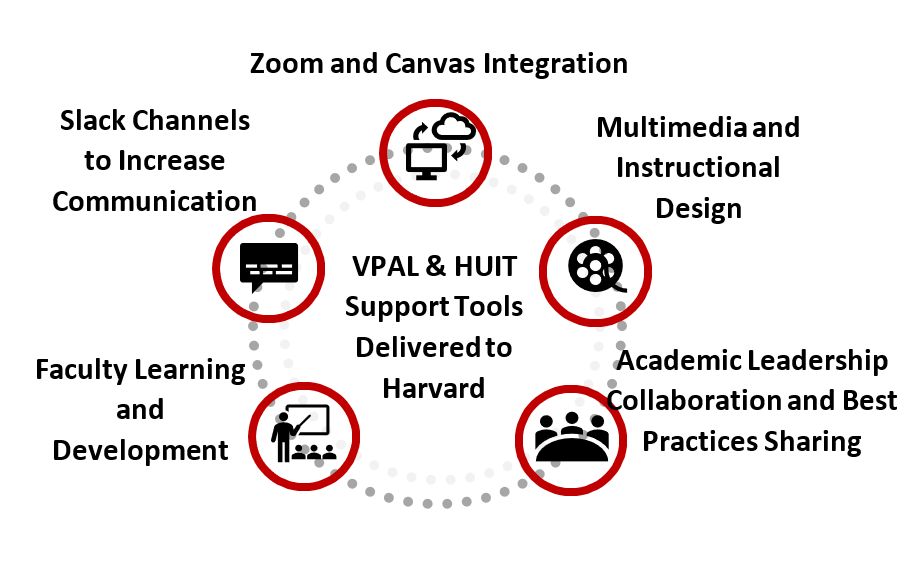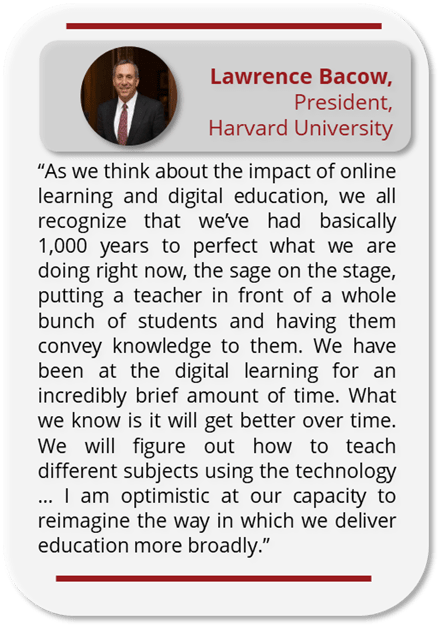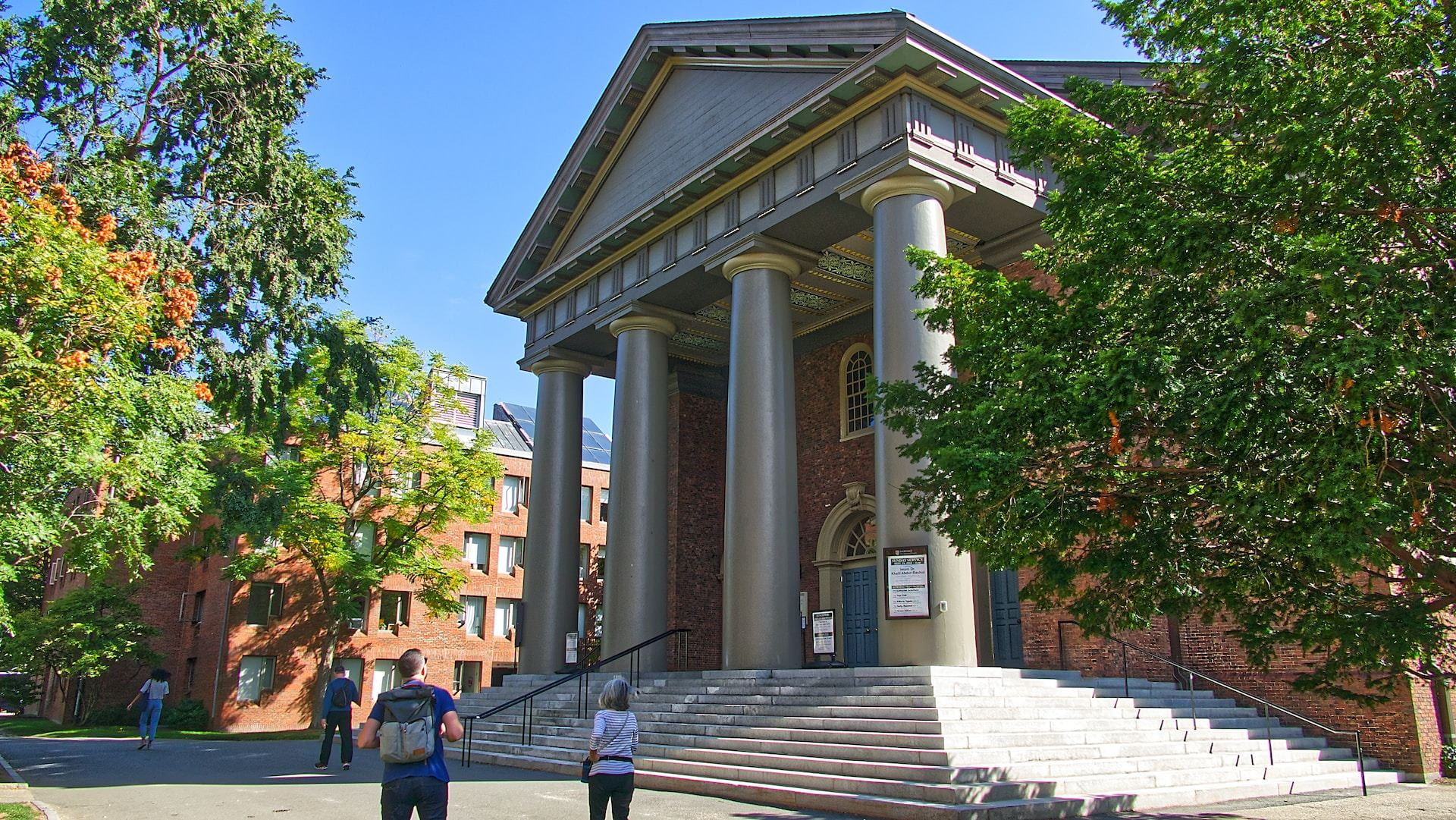Looking Back At Where We Started
In March 2020, all teaching and learning at Harvard moved online, creating unique and unexpected challenges along with significant struggles and stress. This forced change also sparked a period of innovation, experiments, and new initiatives across Harvard’s classrooms and programs. Over the next year and a half, our students and faculty found new and impactful ways to connect, explore, and advance our collective intellectual efforts.
The Harvard Future of Teaching and Learning (FTL) task force was convened to synthesize and assess the many lessons learned and solutions uncovered during this transformative period. Our full report explores multifaceted considerations, principles, and recommendations to build a strategic roadmap for Harvard’s teaching and learning future and outline key enablers of that vision.
In this micro-report, we capture key concepts from our full report beginning with the infrastructure and expertise that laid the foundation for Harvard to pivot swiftly and successfully to online instruction. We also share innovations that enabled teaching and learning to not only continue, but even flourish, across schools and divisions. We conclude with taking a step back to ask: What does this all mean not only for the future of teaching and learning at Harvard University, but for the future of higher education? Which aspects of remote learning might we want to preserve or expand? And how might we maintain a culture of innovation for teaching and learning at Harvard?
Anchored in our campus experience, strengthened by our talents and resources, and bolstered by our best innovations, we aspire to create new transformative opportunities for teaching and learning at Harvard and beyond. Most importantly, we have an unprecedented opportunity to make learning more engaging, impactful, and equitable for our students everywhere.
Using Our Strong Foundation in Online Instruction to Pivot
How We Capitalized on Harvard’s Experience with Online Teaching and Learning.

Nearly a decade of investment in online learning enabled Harvard to rapidly pivot to remote teaching and learning during the 2020-2021 academic year. Starting as early as 2012, Harvard began building up considerable assets (e.g., edX and HBS Online) and capabilities around online instruction.
The experiences gained by Harvard Schools and faculty through asynchronous, synchronous, and hybrid offerings were vital in the 2020 transition to remote teaching. While some assets and platforms were less easily leveraged for use during the pandemic, the broad set of capabilities and experiences were invaluable.

Catalyzing Teaching & Learning Innovation
How We Stretched and Strengthened our Online Teaching Capabilities Over Time.
Many lessons learned about active learning pedagogies, sustained engagement online, digital learning classrooms, and more, emerged thanks to the extensive individual and collective innovations throughout the Harvard community. When we abruptly transitioned to remote teaching, leaders, faculty, and staff with online teaching experience leaned spiritedly into supporting their colleagues across Harvard. Academic technology and learning centers quickly geared up powerful web-based resources and monitored bandwidth speeds. Within hours, schools and university-wide offices created materials containing guidance for the thousands who had never imagined teaching or learning remotely. Among the numerous learnings we discuss in our full report, two key discoveries emerged:
Faculty Successfully Capitalized on New Opportunities Enabled by Blended Learning
- Bridging Space between Learners and Instructors
Online learning mitigated geographic dispersion among students and enabled guest speakers to connect with students across the globe - Enhancing Personalization for Learners
Faculty often flipped the classroom experience, carefully tracked learning behaviors and trends, and offered flexible evaluations - Increasing Interactivity
Faculty used online tools to create highly collaborative workspaces such as class polling capabilities and virtual breakout rooms
Centralized Efforts Strengthened Local Teaching Innovation across Harvard Schools
- Surfacing Teaching Experiences
During the pandemic, our faculty and staff came together like never before. They collaborated on, crowdsourced, and shared emerging best practices across schools. - Centralized Support Efforts were Vital
The Office of the Vice Provost for Advances in Learning (VPAL), Harvard University Information Technology (HUIT), HILT’s Teaching & Learning Consortium (TLC), libraries, and museums stepped up their support as faculty managed many new challenges. - Respect and Support for Tailored Approaches
Rather than recommending a “one size fits all” approach, central offices providedrespectful guidance and support for the autonomy and creativity of each school.

Looking Forward
What We Identified as Key Areas of Focus.
What do the lessons from remote teaching experiences imply for how Harvard can enhance the in-person learning experience for students on our campus? How do we enrich the online experience for learners unable to come to campus? A range of opportunities present themselves. Many involve amplifying existing practices and programs. In addition, the task force proposes three new major strategic directions:
Reimagining the Classroom
Blended Classrooms, Courses, and Curricular Pathways That Enhance the Student Experience
- Meet students where they are: accommodate learner needs, honor identities, and tailor instruction
- Prioritize interactive pedagogy and peer-to-peer teaching and learning
- Blend multilocal experiences through hybrid programs
- Build lifelong community engagement
Enriching Content
Creating a New, Unified, and Coherent Strategy for Digital-first and Short-Form Learning Experiences
- Create modular online learning experiences for use in residential courses and online offerings
- Meaningfully expand the impact of Harvard’s teaching beyond the physical classroom
Expanding Community
Reimagining Harvard’s Global Online Learning Experience
- Develop a new platform for connecting the global Harvard community
- Explore new ways to translate a residential component to online programs
- Connect the research community, learners, and alumni
Taken all together, these three Strategic Action Areas can enable Harvard to create a new type of learning and research community, working to address the world’s most challenging issues while advancing Harvard’s mission of education and scholarship. This opportunity derives from the breadth of the university’s resources and our global reputation as a nexus of intellectual leadership and academic excellence.
Calling Us To Act
How We Aim to Expand Upon Our Successes and Lessons Learned.
For centuries, Harvard has been deeply committed to excellence and to the opportunities it creates. Now, we have an opportunity to not merely bounce back but rather to stride forward. We are redoubling that commitment and with it the determination and the responsibility to enrich education throughout the world.
Mindsets have changed. Before our forced shift to remote teaching, we imagine that it could have taken decades to have serious conversations about the opportunities for blended learning. Now, academia is open to these conversations. Our community is embracing change and embarking on new pedagogical pathways. We are moving away from explaining why transformation is needed and instead asking how we can realize our full potential.
While in the full report we propose concrete ideas about how to proceed in each Strategic Action Area, we also propose some basic principles to anchor all of Harvard’s future efforts around teaching and learning:
- Offer teaching and learning experiences that are “uniquely Harvard,” whether they involve interactions with Harvard faculty and teaching fellows; Harvard museums, library, and archive assets; Harvard digital content; or other aspects of the Harvard campus experience.
- Thoughtfully and creatively incorporate the benefits of technology and remote education, always remembering that technology is to enable teaching and learning and is not an end unto itself.
- Engage students wherever they live, whether in Cambridge/Boston or elsewhere, and without necessarily increasing our physical footprint.
- Challenge the assumption that high-quality education must only be in-person. Although our various learner experiences won’t be identical, Harvard will seek to deliver excellent outcomes.
- Diversity, equity, and inclusion will inform all teaching and learning activities.
- Innovations and investments in teaching and learning will continue at multiple levels: the faculty and course level, the program and school levels, and at the university as a whole. Innovation on the front lines will be facilitated by central support, leveraging shared insights, dedicated resources, and fixed investments across Harvard.
- Any meaningful expansion of Harvard’s teaching and learning activities will be guided by the principle of engagement at scale, not one or the other. To achieve both high touch and global reach, we will foster online communities that preserve the core of the Harvard experience.

Conclusion
We are ready to strive forward with learners and communities, partners, and institutions, to revolutionize equity and access to education worldwide.
We urge the university to strive for a broad range of approaches, unified by such core themes as deliberate, thoughtful learning design, a focus on outcomes, engagement with the faculty and the student body, building enduring social connections and a relationship with the campus. Together, the recommendations in this report establish an ambitious yet achievable vision: to heighten innovation, deepen collaboration, and expand the excellence Harvard has always sought to inspire.
